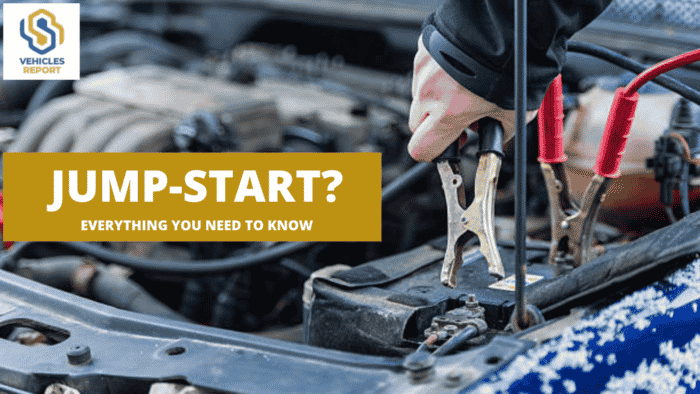Rendering help is good but has nothing to do with whether jump-starting a car can hurt your car or not.
Jump-starting a car can affect your car depending on a number of reasons which are discussed in this eye-opener. When you have a friend or neighbor who has a dead battery, you might want to let them use your car to jump-start their car.
Nevertheless, you might also be thinking about whether it could damage your car in the process. Even if you like to help, you wouldn’t like to do anything to damage your vehicle right? So find out more.
Usually, offering someone else’s car a jump start won’t hurt your car. This would take charge of your battery but you could easily recharge it again by using your car.
No serious damage is caused to your car if the jump-start is successful but in instances where it’s not properly done, there is a high chance of your car getting damaged.
Here’s what you should do.
How to Avoid Damage to a Car During a Jump Start
When jump-starting a car, there is always the risk of electrical damage and this usually happens when the person jump-starting the car isn’t experienced. Even either or both of the cars could be heavily damaged if care is not taken.
You don’t want to jump-start another car and damage your car in the process even if you have a strong desire to help. Though there are roadside mechanics that could easily fix a car that has a dead battery.
But if you really want to offer the assistance, you could go ahead with the jump start procedure. Of course, you won’t have anybody to blame if jump-starting the car hurts your car.
If you don’t want to experience this, read the tips below:
Connect the Cables Properly
The rule of thumb to prevent damage to your car while jump-starting another car is to connect the cables properly and in the right order.
Since the jumper cables are color-coded, it’s easier to distinguish and connect to the right battery terminals. Once this is sorted, you’re only left to think about the order on how to attach the cables.
This is likely to happen when the procedure of jump starting another car is done in the following ways:
1. When You Cross the Cables
If you attach the positive cable to the negative terminal, a short circuit is expected to occur. When this is the case, the electrical or computer parts of the car could be burnt.
You might not discover this issue until you try to use the radio or use other computer parts and they don’t work again.
This can seriously affect other parts of your vehicle that connect and take electrical charge when the short circuit occurs.
2. Wrong Succession Of Attachment
Normally, the jump starting procedure involves attaching the positive ends first though it doesn’t matter which one you connect first so far you did it properly.
Nevertheless,the positive terminals should be first connected, all for safety reasons.
By this, you can avoid any short circuit shorting while you’re setting up the other cables. This is it: If you connect the negative terminals first, then most of the car, except for the positive poles, are connected.
So any mistake of touching the positive clip to any part of the vehicle could result in a short circuit. But If the positive terminals are first connected, a wrong or accidental touching of the negative cable with other car parts will not lead to any short.
Is It Bad to Jump Start Your Battery?
Transient variations in voltage or current are common when jump-starting and there are chances that jump-starting your car may cause some damage.
This occurs because of the connection of two automotive batteries together which lacks a medium between the two components. However, deploying the right tool (jumper booster pack) and strategy will minimize the likelihood of any damage to your car or battery.
In the jump-starting procedure, the electronics in your car are not only affected, but it is also possible to damage the car battery.
Since batteries are rated at 12 volts, they tend not to communicate well when shorted together, resulting in a loop of flowing current to each other. Your car has a lot of fuses to protect against spikes in current and the battery itself is not really protected in this case.
So, your car battery is fully naked when you jump-start your car and there may be direct damage as a result.
Does My Battery Type Matter?
Your battery is at more risk if it’s the maintenance type. A maintenance-type battery is not sealed and gas may exude and cause a fire outbreak if any sparks happen.
A great way to keep the possibility of any sparks low to not happening at all, make sure you don’t spark the battery by connecting negative to the ground – it has to be negative to the negative terminal of the battery.
Seek professional help if jump-starting your car damages the car’s electrical modules or other parts.
Fixing the issues may be challenging for a mechanic and they may cause all kinds of false problems which may lead to a costlier labor charge.
How to Avoid a Dead Battery in the First Place
1. Drive Your Car Regularly
Driving your car regularly allows the alternator to maintain the battery’s charge level.
2. Use a Battery Maintainer or Charger
In instances where you need to park your car for a long period of time, try using a battery maintainer or trickle charger. These devices are built to replenish a drained battery.
Besides, some recent models can fill up the battery and have the possibility of extending battery service life.
3. Perform Routine Battery Maintenance
Routine inspection is as important for the battery as it is for the rest of the car.
It’s also recommended that the battery load be tested annually after it’s two years old – if you reside in a warmer climate) and four years – if you live in a colder climate.
This will help you to determine the ability of your car battery to hold voltage when in use and the results will let you know when it’s time to start shopping for a new battery.
Want to know about the service history of any used car? Get our up-to-date vehicle history report.
4. Replace an Expired Car Battery
According to The American Automobile Association (AAA), a typical car battery lasts three to five years.
This depends on the use and temperatures. Car battery life is more affected by hot weather than cold weather.
It’s better to replace an expired battery than to stretch every last start from it. You don’t want to risk being stranded right?
Get our OEM window sticker to know about the manufacturer’s information on any used car.
Ten Common Steps to Jump-Start a Car
- Park the two cars close to the next in such a way that they don’t touch one another. This should allow the cables of the car to be used for jump-starting and the one with the dead battery to reach both ends.
- Make sure the ignition is turned off on both cars.
- First, clamp one end of the positive cable to the positive clamp of the dead battery. Have somebody connect the other end of that cable to the positive clamp of the other battery.
- Next, connect the negative cable to the negative terminal on the good battery.
- Finally, connect the other end of the negative cable to a ground on the vehicle with the dead battery. This can either be the engine block or another metal surface away from the battery. Be extremely careful not to touch the two ends of the cable together when this is going on.
- Start the rescue car that is providing the electricity.
- Then start the car with the dead/weak battery. If it fails to start, check your connections and tighten them very well.
- If the car starts, allow the car that is being jump-started to run for at least 20 minutes to allow the battery to recharge. Then shut it off afterward.
- If it still fails to start, there may be some other problem with the car. You can call your local mechanic shop for help.
- Unplug the cables in the reverse order.
Conclusion
When you have a dead battery, the common fix is to jump-start the battery with another car using jumper cables.
However, if you don’t take the necessary steps, there is the possibility of causing damage to the vehicle during the jump-starting procedure.
If an attempt is made to jump-start a damaged or frozen battery, it could result in significant damage to the vehicle and even to the individuals in close proximity to the vehicle.








